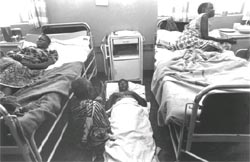Gender bias
Gender bias

aids has long been considered primarily a men's disease. But late last year, the United Nations reported for the first time that more women than men were infected with the aids virus in Africa, the site of the vast majority of such infections in the world. Of the 22.3 million adults in sub-Sahara Africa infected with hiv , the aids virus, 12.2 million, or 55 per cent, are women. This kind of data was never available earlier as also the reasons for this shift. It suggests that as hiv was spread in Africa primarily through heterosexual intercourse, the virus passes more easily from men to women than from women to men.
"Ten years ago, it was hard to make people listen when we were saying aids wasn't just a man's disease,' said Peter Piot, head of unaids spearheading global aids control. Infection rates among women are much lower in the United States and other developed countries than in Africa. But more women, primarily in minority groups, are becoming infected through heterosexual sex in us as well.
The new evidence that Africa has six infected women for every five infected men comes from a number of studies in several African countries. Another factor in the shifting demographics in Africa, the report said, is the different age patterns of hiv infection in men and women.
So although women now comprise almost half of new hiv - 1 infections worldwide, ironically much of what we know about this devastating virus has been gleaned from studies of men. New studies have focused on women and new research adds to growing evidence that hiv transmission via heterosexual contact is different for men and women. Women, it seems, are usually infected by many different forms of the virus, men, by just one ( Nature Medicine, Vol 6, No 1).
Julie Overbaugh and colleagues of the Fred Hutchinson Cancer Centre, Seattle, Washington, report this highlighting the gender differences in the hiv type 1 virus. This is an important finding, given that the search is on for an hiv -1 vaccine that will be effective all over the world. It also highlights, as many others studies have done recently, the dangers of extrapolating information about female health and disease from studies on males.
An estimated 70 per cent of all hiv -positive individuals live in Sub-Saharan Africa. So the researchers looked at 10 men and 32 women from Kenya - large numbers in hiv -research terms. All the subjects had similar sexual histories (numbers of partners, involvement with prostitutes and so on) and comparable levels of other sexually transmitted diseases. Sexual transmission of hiv from man to woman results in a more diverse







